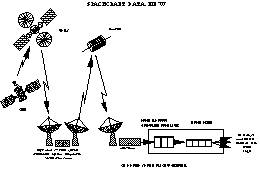

There are two parts to the GRB Coordinates Network (GCN; Transient Astronomy Network(TAN): (1) the distribution of GRB/transient locations detected by various spacecraft, and (2) receiving and automatically distributing to the GRB/transient community prose-style e-mail messages about follow-up observations on various GRBs/transient.
Part 1 (the GCN Notices):
This portion of GCN/TAN consists of distributing the GRB/transient
locations determined by the Fermi, Swift, INTEGRAL, IPN, MOA (grav-lensing events), and others.
The collection and distribtuion of these Notices is done without any hmans-in-the-loop,
and as such for missions with real-time downlinks, the time delays from with the GRB/transient happened
to when the Notices is being sent out the customer is in the 2-10 sec range.
Many socket-based and email-based formats are protocols are available.
This combining of all the sources of GRB/transient location information
into a single network means that sites need only maintain a single interface
for all their GRB/transient needs.
The same distribution methods as developed during the BACODINE days are still
available in GCN, plus others have been added.
Part 2 (the GCN Circulars):
This part allows the GRB community to submit messages to a central queue
where they are automatically vetted and distributed (via email) to the entire GRB community.
These are prose-style messages (as opposed to the "TOKEN: value" style of the GCN e-mail Notices)
from follow-up observers reporting on their results (detections or upper limites) or
for coordinating with others.
The diagram below show schematically the flow of information from the varous missions and instruments into GCN and then back out to the world community.
...insert the contribution/distribution diagram here...
The Early Days (when it was called BACODINE: BAtse COordinates DIstribution NEtwork):
The real-time transmission of the data from the COMPTON-GRO spacecraft allows
for access to BATSE instrument data that can be used to make simultaneous
and near-simultaneous multi-band observations of Gamma Ray Bursts (GRBs).
The BACODINE system (1) monitors this telemetry stream, (2) extracts the
appropriate information from the BATSE portion, (3) detects the occurrence of a GRB,
(4) calculates the approximate coordinates for the burst, and
(5) distributes those coordinates to instruments, observatories, and other
interested parties around the world. This is done with custom hardware
plus software located at the NASA Goddard Space Flight Center mission operations
center for CGRO. The maximum time delay between the arrival of the GRB
photons at the BATSE detectors and the calculation of the coordinates is 5.5 seconds.
The accuracy of the calculated coordinates is ~10 degrees (typical worst case).
The coordinates can be distributed by phone connections, by direct
computer-to-computer socket connections over the Internet, by e-mail,
and by alpha-numeric pager to any optical, infrared, radio, and TeV telescope
systems with wide field-of-view capabilities.
This rapid distribution of coordinates
(0.3 to 30 sec, depending on the distribution method) allows for a 4 to 6
order of magnitude improvement over previous efforts in the response time of follow-up observations
of the optical and radio emission of GRBs.
This greatly increased the likelihood of a detection and hence,
of the identification of the counterparts of GRBs and
solving one of astrophysics' greatest mysteries.
And when other missions/instruments were added (beyond the original CGRO-BATSE source), the name was changed from BACODINE to the more general GCN name (and then more non-GRB transients so it sometimes called GCN/TAN).
The pictures below show schematically the flow of information through the telemetry system and a world map of the BACODINE sites. In the left picture, the gamma rays from a GRB hit the BATSE detectors on CGRO, and then the telemetry data are transmitted up to a TDRS satellite, down to White Sands, up to DOMSAT, and down to GFSC, where they are processed by BACODINE. The right picture shows the locations around the world of the various BACODINE sites.


The GCN/TAN contact is: Scott Barthelmy,
GCN Team
This file was last modified on 14-Jan-17.